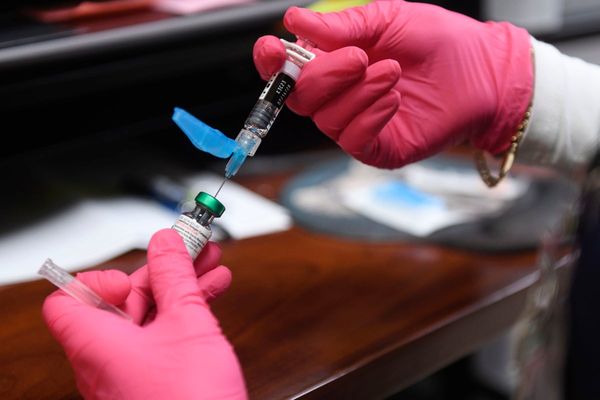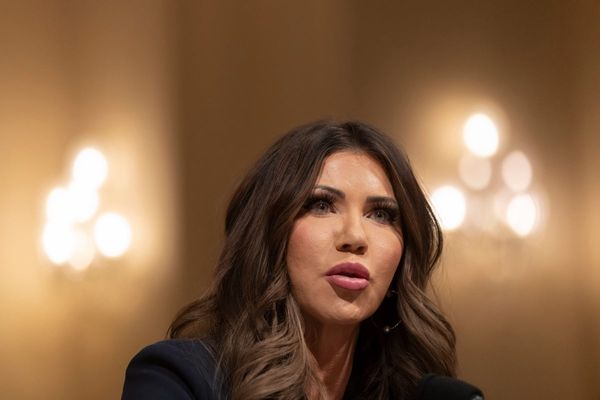
Male TV presenters in Afghanistan are wearing face masks on screen to show solidarity after the Taliban issued an order that all women on news channels must cover their faces.
In a protest dubbed #FreeHerFace on social media, men on Tolo News wore masks to mimic the effect of the face veil their female colleagues have been forced to wear after a Taliban crackdown.
The Taliban’s Ministry of Propagation of Virtue and Prevention of Vice ordered all Afghan media outlets to use masks for female presenters. The decision was final and there was no room for debate, it said.
Sebghat Sepehr presented the news wearing a mask shortly after the order was made public.
It follows a decree issued in early May that all women must cover their faces in public and male relatives face fines or jail if they do not adhere. Many women in cities such as Kabul, including TV presenters, defied the order.
Lema Spesali, 27, a news anchor for 1TV in Kabul, told the Guardian she was given the news of the Taliban’s latest decree on arrival at work on Sunday morning. “Two Taliban members came to our office and said the decision on compulsory masks for female anchors must be implemented.
“We had an office meeting and had to accept the Taliban order, but decided that male colleagues should also wear masks and stand by female colleagues.”
During nine months of Taliban rule the presenter has also been forced to swap her favourite colourful clothes for long dresses, and is disappointed and shocked by the latest blow. “I cannot breathe. I cannot get oxygen,” she said. “We need to pronounce the words accurately. It is very difficult to read the news with a mask.”

A 29-year-old male anchor on a private television channel, who did not want to be named due to security concerns, told the Guardian he and other male colleagues had put on masks to work in the past two days. When the Taliban order reached their office, he said, female colleagues were clearly dispirited. “Performing while wearing a mask is very annoying,” he said. “When I perform with a mask, I feel like someone has grabbed me by the throat and I cannot speak.”
He said he and his colleagues will continue to protest until the Taliban reconsider their decision.
In an interview with CNN, former Afghan president, Hamid Karzai, among others, called on female presenters to defy the Taliban order and not wear masks. The Taliban’s official Twitter account replied to Karzai: “In the past two decades, Mr Karzai wanted any kind of freedom for the Afghan sisters and paving the way for the freedoms to make foreigners happy, but his wife did not appear in any media as she wanted for the rest of Afghans.”
The Ministry of the Propagation of Virtue and Prevention of Vice has announced that wearing a hijab is “necessary”, and the best type is the burqa and the black Arab hijab.
According to the new order, in the first instance of the order being disobeyed the Taliban will advise and guide unveiled woman; as a second step summon her; the third step is three days’ imprisonment. As a fourth step, the guardian of the unveiled woman will be taken to court and sentenced to an appropriate punishment.
In the first months of the latest Taliban rule in Afghanistan, an instruction made the hijab mandatory for female journalists, but not all women complied. However, by September fewer than 100 of the 700 female journalists in Afghanistan were still working.
Another male presenter, who did not want to be named, said that while wearing a mask for the last two days he realised how difficult it is to be a woman in a country like Afghanistan. “When I saw my colleague put a mask on her face and appear on the TV screen, I shed tears,” the male presenter said. “I then decided to wear a mask myself and protest.”
Sahar Fetrat, an Afghan feminist activist who works for Human Rights Watch, told the Guardian: “Male journalists have been wearing face masks. It’s a great act. It’s one of the few instances where Afghan men are doing something symbolic because all the resistance and protests against the veil so far has been by women.
“The question is would they wear a hijab? Would they cover themselves in a burqa if they were asked to? But how far will you go? The whole country wearing the burqa?And what do we do with that anger and emotion? Where does it take us? These are important questions.”







